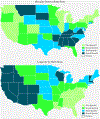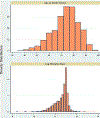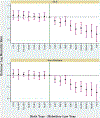Long-Term Health Benefits of Occupational Licensing: Evidence from Midwifery Laws
- PMID: 37722296
- PMCID: PMC10841694
- DOI: 10.1016/j.jhealeco.2023.102807
Long-Term Health Benefits of Occupational Licensing: Evidence from Midwifery Laws
Abstract
During the late 19th and early 20th century, several states mandated midwifery licensing requirements to improve midwives' knowledge, education, and quality. Previous studies point to the health benefits of midwifery quality improvements for maternal and infant health outcomes. This paper exploits the staggered adoption of midwifery laws across states using event-study and difference-in-difference frameworks. We use the universe of death records in the US over the years 1979-2020 and find that exposure to a midwifery licensing law at birth is associated with a 2.5 percent reduction in cumulative mortality rates and an increase of 0.6 months in longevity during adulthood and old age. The effects are concentrated on deaths due to infectious diseases, neoplasm diseases, and suicide mortality. We also show that the impacts are confined among blacks and are slightly larger among males. Additional analyses using alternative data sources suggest small but significant increases in educational attainments, income, measures of socioeconomic status, employment, and measures of height as potential mechanism channels. We provide a discussion on the economic magnitude and policy implication of the results.
Keywords: Health; Historical Data; Longevity; Midwifery; Mortality; Occupational Licensing.
Copyright © 2023 Elsevier B.V. All rights reserved.
Conflict of interest statement
Declaration of Competing Interest The author claims no conflict of interest.
Figures






Similar articles
-
Associations Between State Practice Regulations and Access to Midwifery Care.J Midwifery Womens Health. 2024 Jan-Feb;69(1):17-24. doi: 10.1111/jmwh.13528. Epub 2023 Jun 24. J Midwifery Womens Health. 2024. PMID: 37354043
-
Womb to wisdom: Early-life exposure to midwifery laws and later-life disability.Soc Sci Med. 2025 May;372:117973. doi: 10.1016/j.socscimed.2025.117973. Epub 2025 Mar 21. Soc Sci Med. 2025. PMID: 40147339
-
Midwifery Autonomy and Employment Changes During the Early COVID-19 Pandemic.J Midwifery Womens Health. 2022 Sep;67(5):608-617. doi: 10.1111/jmwh.13400. Epub 2022 Sep 13. J Midwifery Womens Health. 2022. PMID: 36098518
-
The Effect of Prior Work Experiences on the Preparation and Employment of Early-Career Midwives.J Midwifery Womens Health. 2018 Nov;63(6):668-677. doi: 10.1111/jmwh.12910. Epub 2018 Oct 7. J Midwifery Womens Health. 2018. PMID: 30294893 Review.
-
A Comparative Workforce Study of Midwives Practicing in the State of Texas.J Midwifery Womens Health. 2018 Nov;63(6):682-692. doi: 10.1111/jmwh.12739. Epub 2018 Jun 8. J Midwifery Womens Health. 2018. PMID: 29883047 Free PMC article. Review.
Cited by
-
Early-Life Economic Conditions and Old-Age Male Mortality: Evidence from Historical County-Level Bank Deposit Data.J Popul Econ. 2024 Mar;37(1):32. doi: 10.1007/s00148-024-01007-w. Epub 2024 Feb 29. J Popul Econ. 2024. PMID: 39301052 Free PMC article.
References
-
- Aaronson D, Mazumder B, Sanders SG, Taylor EJ, 2021. Estimating the effect of school quality on mortality in the presence of migration: Evidence from the jim crow south. Journal of Labor Economics 39 (2), 527–558. 10.1086/709783/SUPPL_FILE/17462DATA.ZIP. - DOI
-
- Almond D, Currie J, 2011a. Human capital development before age five. In: HANDBOOK OF LABOR ECONOMICS, 4. Elsevier. 10.1016/S0169-7218(11)02413-0. - DOI
-
- Almond D, Currie J, Duque V, 2018. Childhood circumstances and adult outcomes: Act II. Journal of Economic Literature 56 (4), 1360–1446.
Publication types
MeSH terms
Grants and funding
LinkOut - more resources
Full Text Sources

